Hawaii, with its lush and vibrant flora, is home to a several types of ginger flowers that add beauty and fragrance to its tropical landscape.
Each ginger species found on the islands brings its unique charm, history, and uses.
Here we’ll explore nine distinct types of ginger you can encounter in Hawaii: Kahili Ginger (Hedychium gardnerianum), Awapuhi Kuahiwi, Hedychium coronarium, Alpinia zerumbet, Alpinia purpurata, Etlingera elatior, Culinary Ginger (Zingiber officinale), Turmeric (Curcuma longa), and Blue Ginger (Dichorisandra thyrsiflora).
Don’t miss out on seeing and smelling these beautiful Hawaiian gingers on your next hike or visit to a notional garden on Hawaii. Check out our tips on Best Nature Hikes On Hawaii and Favorite Hawaiian Botanical Gardens & Arboretums.
Discovering the Diverse World of Ginger Flowers in Hawaii
Kahili Ginger (Hedychium gardnerianum)
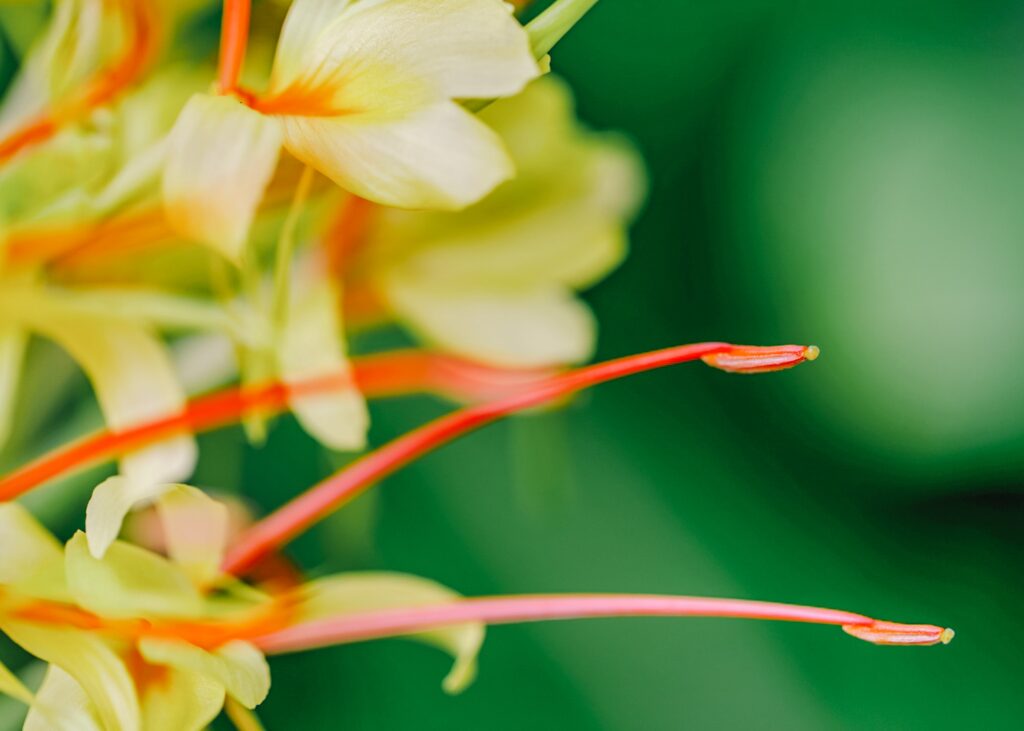
Kahili Ginger, also known as Hedychium gardnerianum, is a beautiful type of ginger flower in Hawaii renowned for its stunning yellow or red flowers. Native to the Himalayas, this ginger thrives in Hawaii’s tropical climate. The tall, fragrant blooms appear from late summer to early fall, making a striking addition to the island’s landscapes. Although beautiful, it’s considered invasive due to its vigorous growth.
Awapuhi Kuahiwi (Zingiber zerumbet)
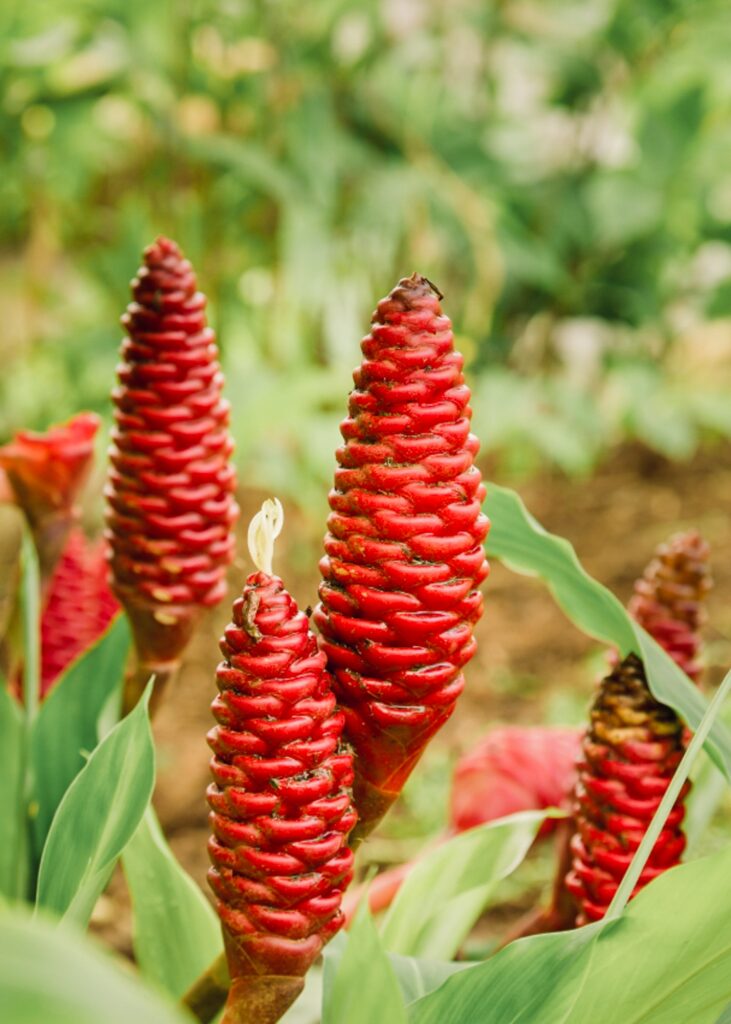
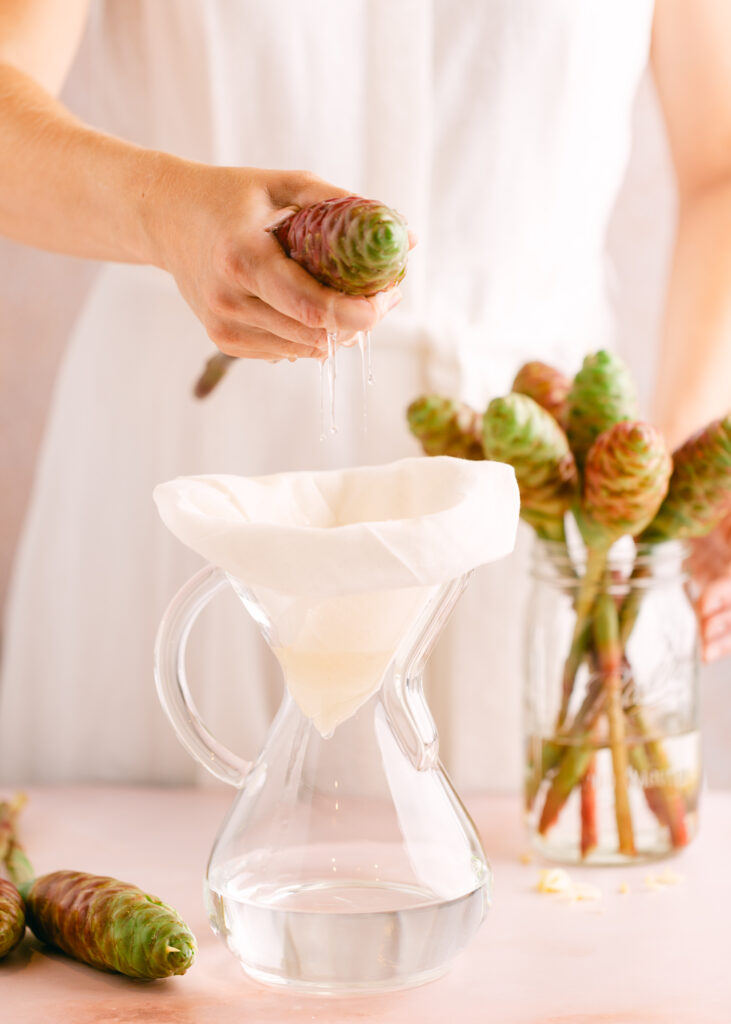
Awapuhi Kuahiwi, commonly known as the Shampoo Ginger, is another iconic ginger flower in Hawaii. Its scientific name is Zingiber zerumbet. This ginger is treasured for its medicinal and cosmetic uses. The rhizomes can be used to soothe ailments, while the extracted liquid from the flower cones is used as a natural shampoo and conditioner, leaving hair soft and fragrant.
White Ginger Lily (Hedychium coronarium)
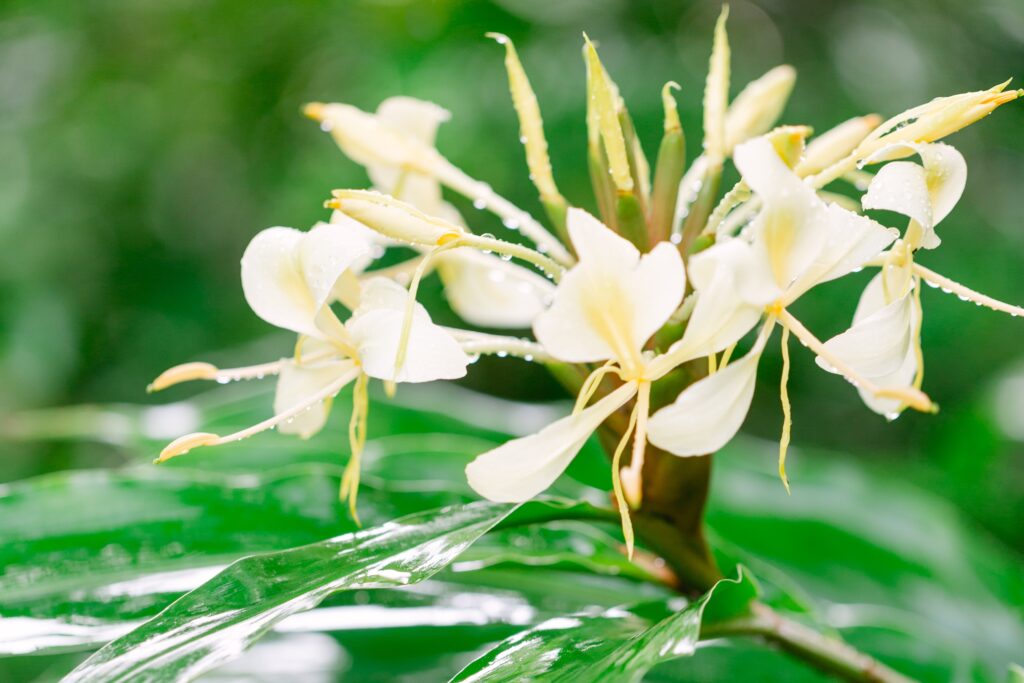
Hedychium coronarium, often referred to as the White Ginger Lily, is admired for its pure white, butterfly-like flowers and intoxicating scent. Originating from the Himalayas, this ginger species has found a welcoming home in Hawaii. It’s commonly planted in gardens for its beauty and aroma, blooming from summer to fall.
Shell Ginger (Alpinia zerumbet)
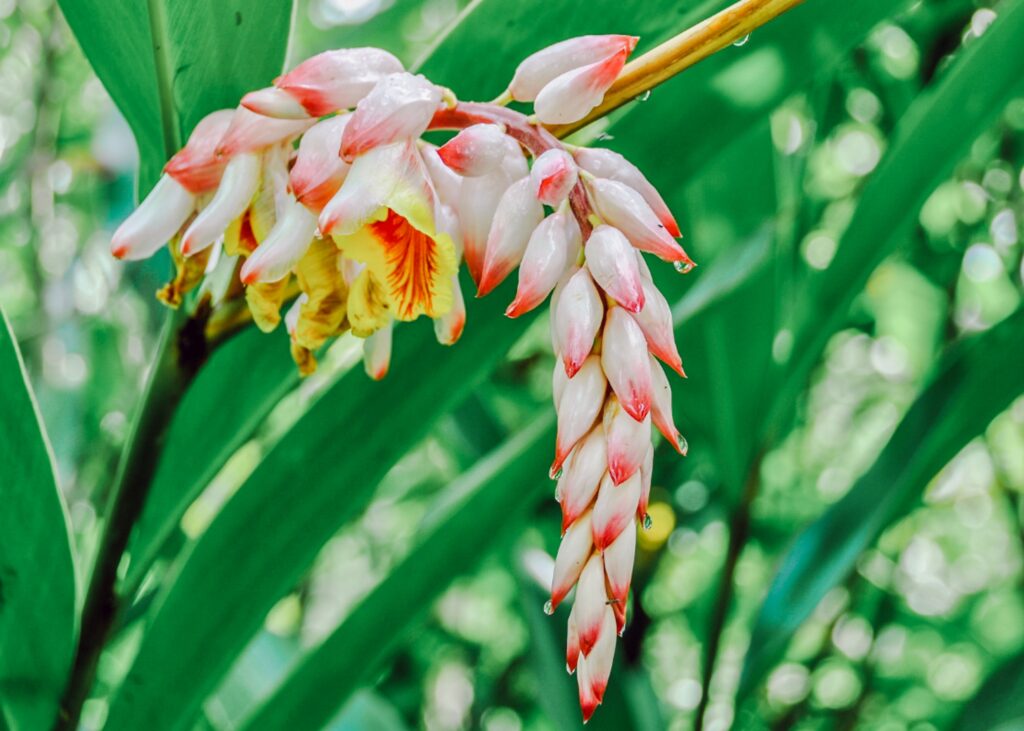
Alpinia zerumbet, also known as Shell Ginger, is named for its shell-like flowers. This ginger is appreciated for its decorative foliage, which features striking green leaves with white and pink variegation. The flowers, while beautiful, are often secondary to the plant’s foliage. It’s a popular choice for landscaping and adding a tropical feel to gardens. On the tropical island Okinawa, Japan shell ginger is grown for its scent and made into essential oil called getto.
Red Ginger (Alpinia purpurata)
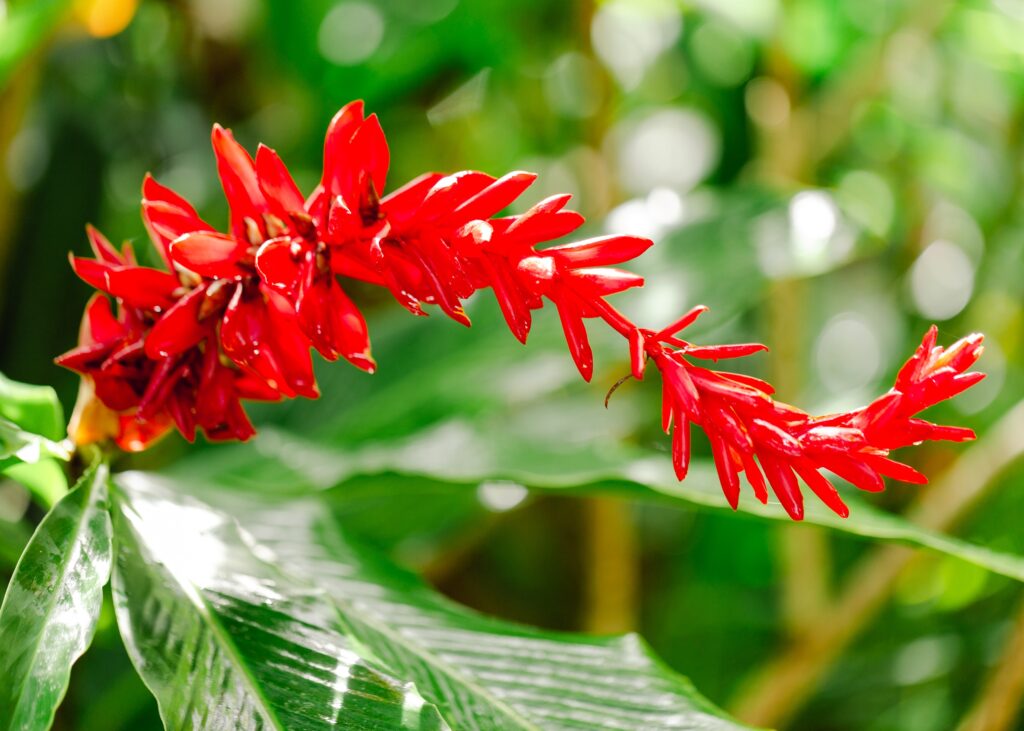
Alpinia purpurata, or Red Ginger, is a vibrant addition to Hawaii’s flora. With its bright red bracts and towering flower spikes, this ginger is a favorite in Hawaiian landscapes and floral arrangements. You can find the best red and pink ginger flower arrangements at Mama’s Fish House. They are so beautiful and perfect, they look fake. Native to Malaysia, it has become a symbol of tropical beauty in Hawaii, blooming year-round in the islands’ warm climate.
Torch Ginger (Etlingera elatior)

Etlingera elatior, known as Torch Ginger, is one of the most dramatic gingers you’ll find. Its large, torch-like inflorescences come in various shades of red, pink, and even white. Native to Southeast Asia, Torch Ginger is used not only for ornamental purposes but also in culinary dishes, adding a unique flavor to traditional recipes.
Blue Ginger (Dichorisandra thyrsiflora)
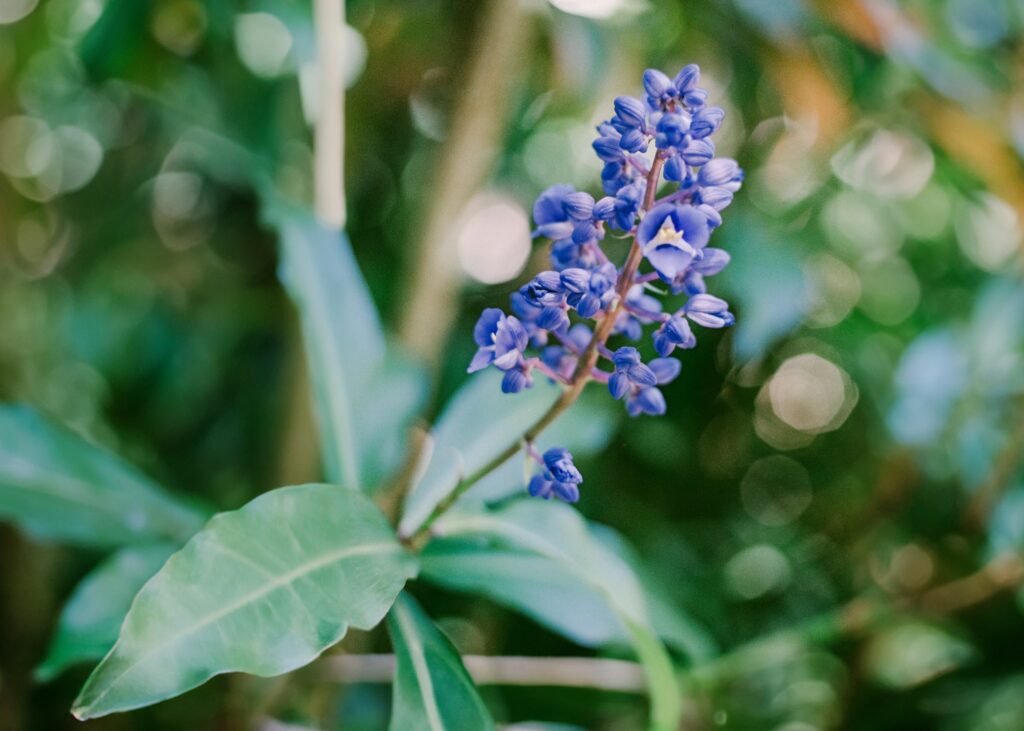
Blue Ginger, scientifically known as Dichorisandra thyrsiflora, is a striking addition to Hawaii’s botanical landscape. Unlike true ginger flowers in Hawaii, Blue Ginger is part of the Commelinaceae family, but it is commonly referred to as ginger due to its similar appearance and growth habits. This plant is admired for its vibrant blue flowers that appear in clusters on tall, sturdy stems. It thrives in Hawaii’s tropical climate, adding a splash of blue to the lush greenery.
Culinary Ginger (Zingiber officinale)
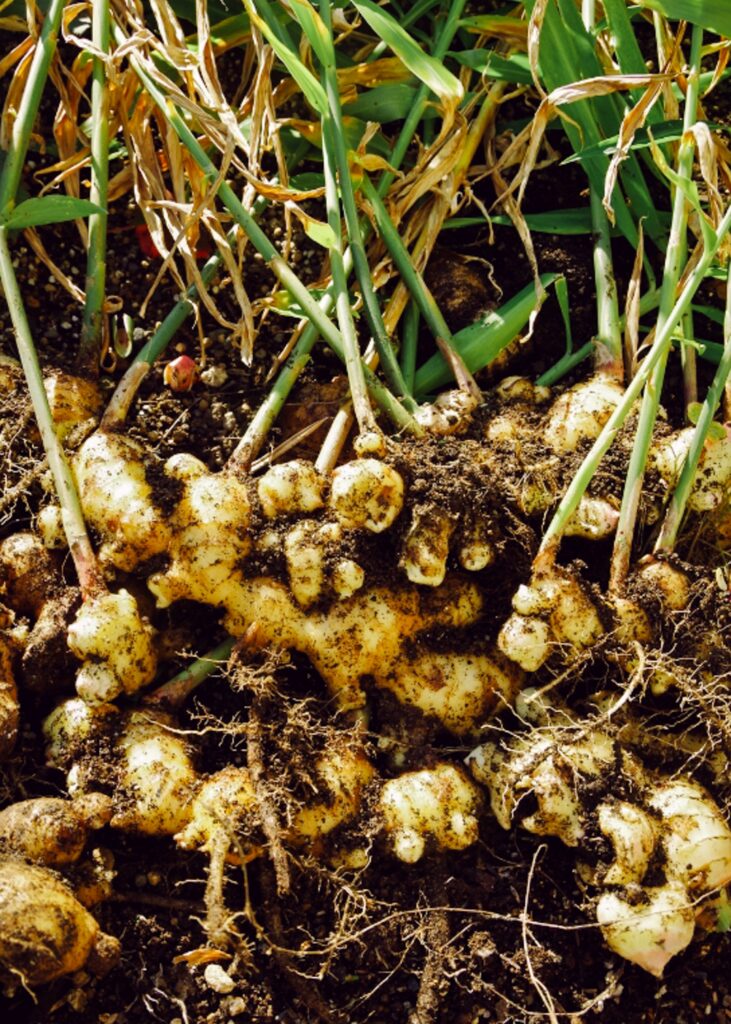

Culinary Ginger, scientifically known as Zingiber officinale, is perhaps the most well-known ginger variety. While the green, unassuming flowers are not really ornamental, its rhizomes are widely used in cooking around the world, adding a spicy and aromatic flavor to dishes. In Hawaii, this ginger is grown both for its culinary uses and its medicinal properties. Fresh ginger root is a staple in many Hawaiian recipes, including teas, marinades, and sauces.
Turmeric (Curcuma longa)

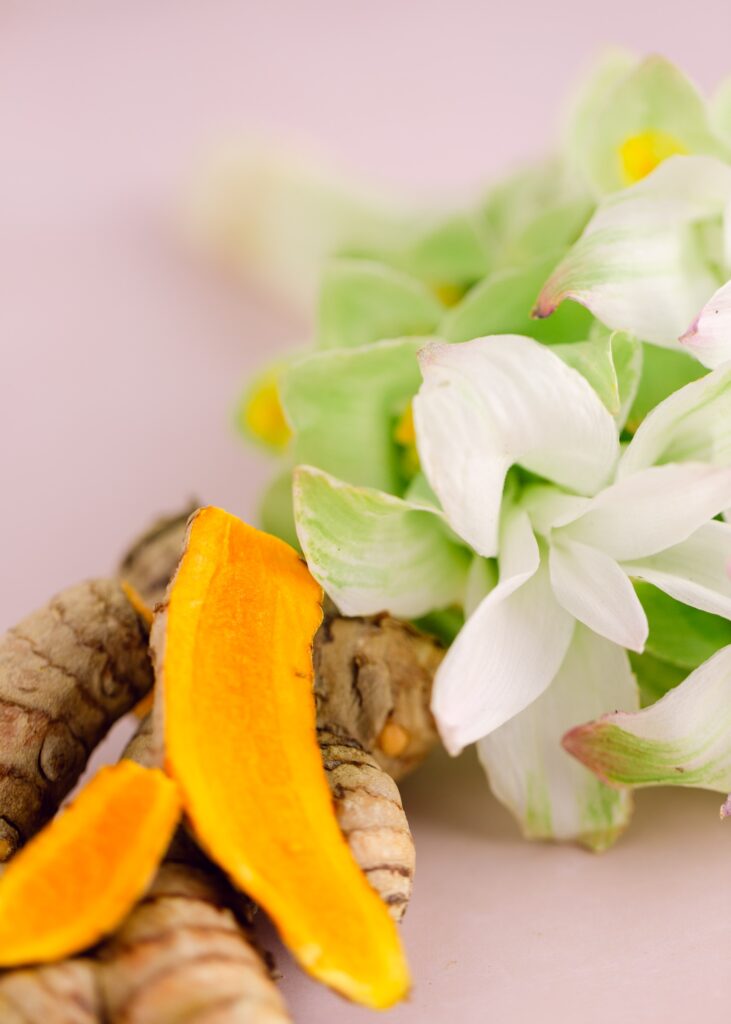
Turmeric, or Curcuma longa, is another significant member of the ginger family. Recognized for its bright orange-yellow rhizomes, turmeric is prized for its culinary and medicinal uses. In Hawaiian cuisine, turmeric is often used in traditional dishes like curry and is known for its anti-inflammatory and antioxidant properties. Turmeric’s vibrant color and health benefits make it a popular ingredient in both cooking and wellness practices.
Frequently Asked Questions about Types of Gingers In Hawaii
What kind of ginger grows in Hawaii?
Hawaii is home to various types of ginger species, including Kahili Ginger, Shampoo Ginger (Awapuhi Kuahiwi), White Ginger Lily (Hedychium coronarium), Shell Ginger (Alpinia zerumbet), Red Ginger (Alpinia purpurata), Torch Ginger (Etlingera elatior), Culinary Ginger (Zingiber officinale), Turmeric (Curcuma longa), and Blue Ginger (Dichorisandra thyrsiflora).
Is the Hawaiian ginger plant edible?
Yes, certain types of ginger plants in Hawaii, such as Culinary Ginger (Zingiber officinale) and Turmeric (Curcuma longa), are edible and widely used in cooking. Other gingers, like Shampoo Ginger (Awapuhi Kuahiwi), have cosmetic and medicinal uses.
Are Ginger Flowers Fragrant?
Yes, several ginger species have fragrant flowers. For instance, Kahili Ginger (Hedychium gardnerianum) and White Ginger Lily (Hedychium coronarium) are particularly known for their sweet and captivating scents. These aromatic blooms add a delightful fragrance to gardens and natural landscapes, enhancing the sensory experience of being outdoors in Hawaii.
When does Hawaiian ginger bloom?
Hedychium gardnerianum, or kahili ginger, typically blooms from late summer to early fall, filling the air with its sweet, exotic fragrance. White ginger, or Hedychium coronarium, known for its delicate and intoxicating scent, blooms primarily in the summer months. Red ginger, Alpinia purpurata, and the torch ginger, Etlingera elatior, are more consistent bloomers, often displaying their vibrant colors year-round.
What are ginger flowers used for?
The different types of ginger flowers in Hawaii are cherished for their many uses. The fragrant Hedychium gardnerianum and Hedychium coronarium are often used in leis and floral arrangements, adding a sweet, exotic aroma. Red ginger (Alpinia purpurata) and torch ginger (Etlingera elatior) are popular in landscaping and as striking centerpieces in floral displays due to their vibrant colors and dramatic appearance.
Additionally, some ginger flowers, like the torch ginger and the bud of the ginger flower, are used in cooking, adding a unique flavor to various dishes.
Historically, ginger flowers were also used in traditional Hawaiian medicine and wellness practice.
In cosmetics, extracts from ginger flowers are valued for their anti-inflammatory and antioxidant properties, making them a popular ingredient in skincare and haircare products, enhancing beauty routines with their natural benefits.
Check out our blog post on 3 Easy DIY Beauty Recipes With Ginger Flowers.
Is Hawaiian ginger invasive?
Some types of gingers in Hawaii, particularly Kahili Ginger (Hedychium gardnerianum), are considered invasive due to their aggressive growth and ability to outcompete native plants. Proper management and control measures are necessary to prevent their spread in certain areas.
How do you take care of Hawaiian ginger?
Hawaiian ginger plants thrive in well-drained soil with partial to full sunlight. Regular watering, especially during dry periods, is essential. Mulching helps retain moisture and suppress weeds. Pruning dead or yellowing leaves promotes healthy growth. Fertilizing with a balanced fertilizer can enhance growth and flowering.
Where to plant Hawaiian ginger?
Plant Hawaiian ginger in a location that receives partial to full sunlight and has well-drained soil. They do well in garden beds, borders, or large containers. Ensure they have enough space to grow, as some species can become quite large.
Does shampoo ginger grow in Hawaii?
Yes, Shampoo Ginger (Zingiber zerumbet), also known as Awapuhi Kuahiwi, grows in Hawaii. It is well-known for its use in traditional Hawaiian medicine and natural hair care products.
Is Awapuhi ginger native to Hawaii?
No, Awapuhi Ginger (Zingiber zerumbet) is not one of the native types of gingers in Hawaii. It is originally from India and other parts of Southeast Asia but has become naturalized in Hawaii and is widely used in traditional Hawaiian practices.
So Many Types of Gingers In Hawaii
The diverse types of gingers in Hawaii are a testament to the islands’ rich botanical heritage. Each species brings its unique beauty, fragrance, and utility, enriching the Hawaiian landscape and culture. Whether you’re drawn to the striking blooms of Kahili Ginger, the soothing properties of Awapuhi Kuahiwi, or the culinary uses of Culinary Ginger and Turmeric, there’s a ginger for every admirer in Hawaii.
Next time you explore the islands, take a moment to appreciate these fascinating plants and their contributions to the tropical paradise we love.
Or order some Hawaiian ginger rhizomes to propagate your own beautiful Hawaiian ginger plants in your home garden.
CONTINUE YOUR SKINCARE JOURNEY WITH MORE HAWAIIAN BEAUTY INGREDIENTS & SECRETS
Check out these popular Hawaii beauty & wellness blog posts:
> Maui Farm Tours: Punakea Palms
If you love Hawaii and you enjoy wellness vacation tips, beauty secrets, and DIY recipes, then sign up for my newsletter where I explore different beauty rituals from Hawaii and around the world.

Must-See Types of Ginger Flowers In Hawaii
Highlights:
Book Now
Experience the transformative power of Hawaii's natural botanical ingredients and harness the healing energy of the islands at our DIY cosmetics workshops, where you create your own personalized beauty products.
Reserve your spot today and embark on a fun, rejuvenating journey of self-care and holistic wellness.